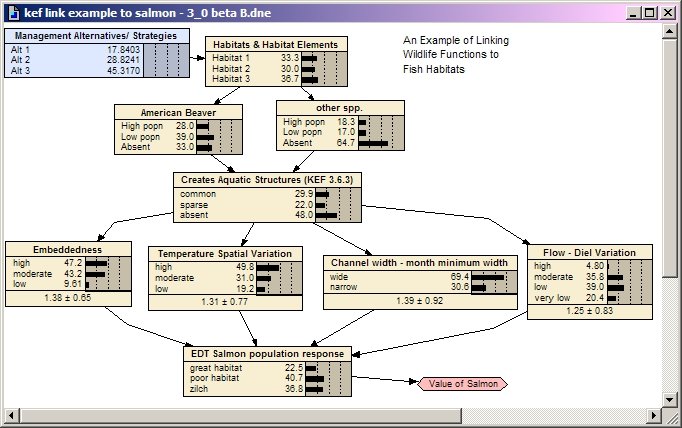Home
Bayesian Networks ~ Applications
New Bayesian Network Model ApplicationsModels and links provided here are those not presented in the book.

One source of new and interesting Bayesian network models is from Norsys, Inc., maker and seller of the BN modeling shell Netica. They post models that can be downloaded at their library site:
Bayes Net Library at Norsys.com
Models of wildlife and natural resources -- by Bruce G. Marcot
Following are selected Bayesian network models developed in the Netica programming shell by Bruce Marcot. They are included here to illustrate the range of scales and issues currently being addressed in various projects and publications.
======
American Marten Habitat and Stressors
This model depicts regional-scale conditions
that affect the density of American martens (a member of the weasel family) in the interior West, U.S. Included are two decision nodes (blue boxes) pertaining to timber management and road development, and four utility nodes (pink hexagons) pertaining to timber and road development cost and the social value of marten populations.
This Netica model can be downloaded here.
======
Marbled Murrelet Significant Threats Analysis
This model was used in a workshop with US Department of Interior's Fish and Wildlife Service, to help estimate the
overall threat influence on a threatened species, the Marbled Murrelet. This species is a robin-sized seabird that flies inland to nest on large moss-covered branches of old-growth trees.
The purpose of this model was to provide the agency with a tool for determining how various potential stressors to the species might organize under four "listing factors" denoted in the U.S.'s Endangered Species Act, and how cumulative influence of all stressors might combine. In this model, the stressors are shown as the yellow input boxes; the four listing factor nodes are the orange intermediate boxes; and the overall influence is the green outcome box.
This is an example of a decision-aiding model, not an ecological prediction model. The model is structured so that it could be run for different combinations of time periods and geographic areas (the pale boxes on the left) to help guide the agency's decision as to whether threats are significantly unique in some areas to warrant that population individual listing status.
This Netica model can be downloaded here.
======
Linking Wildlife Ecological Functions to FishThis demonstration model is an example of how the ecological roles of
terrestrial wildlife can affect fish -- more specifically, how some wildlife species create structures that influence the habitat value and populations of salmon in the Pacific Northwest U.S.
Typically, wildlife and fish are evaluated separately in management plans and ecological assessments. Ongoing work suggests, however, that terrestrial and aquatic ecosystems are linked and influence each other in ways not previously considered.
This model depicts how American beavers and other species (e.g,. nutria) play key ecological roles such as building aquatic structures, namely natural dams in streams, which in turn can change stream channels and water
quality that affect habitat for salmon populations.
Included in this model is a decision node at the top that depicts alternative management activities that in turn influence habitat for the beaver and other terrestrial species; and a utility node at the bottom that depicts the economic or social value of salmon. The model can be run by selecting a management activity at the top, which determines habitat conditions for beaver and other species, and thus those species' ecological activities affecting habitat for salmon. In this way, it can be demonstrated that management of terrestrial wildlife habitat can have an influence on salmon populations and their values.
This Netica model can be downloaded here.
